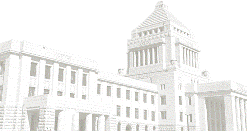
Main Business of Plenary Sittings
Business at plenary sittings is conducted in accordance with the Order of the Day which states the meeting date and time as well as the matters for discussion at that dayfs plenary sitting and their order.
1. Organization of the House
- Election of the presiding officer and deputy presiding officer
- Designation of seats
- Determination of the term of session or the extension of the term of session
- Selection of standing committee members and election of standing committee chairs
- Selection of members of the Deliberative Council on Political Ethics
- Establishment of special committees
The election of the presiding officer and the deputy presiding officer is performed by secret ballot. The House Members write the name of the candidate they want to vote for on the ballot and submit it along with a wooden name card provided at their seat.
2. Designation of the Prime Minister
The designation of the Prime Minister is performed by open ballot in each House. In an open ballot, Members write the name of the candidate they want to vote for on the ballot as well as their own name and submit it.
3. Speeches by Ministers of State and Question-and-Answer Session
Once the National Diet has been convened, a plenary sitting is held in each House and the House is organized. Next, the Opening Ceremony is held. Then, Ministers of State deliver speeches in a plenary sitting at each House.
In an ordinary session, the Prime Minister delivers an address on general policy, and addresses are also given by the Minister for Foreign Affairs, the Minister of Finance, and the Minister of State in charge of economic and fiscal policy. In a special or extraordinary session, usually the Prime Minister gives a policy speech and, when necessary, other Ministers of State also give addresses. After these addresses, Members ask questions (interpellations) on behalf of their political group, and the Prime Minister and other Ministers of State respond.
4. Explanation of Bills and Question-and-Answer Session
In the case of important bills and measures, when the Committee on Rules and Administration deems it particularly necessary, the Members who submitted the bill, if the bill was submitted by House Members — or the Minister of State in question, if the bill was submitted by the Cabinet — explain the purpose of the bill. Questions are then fielded about the bill or measure.
5. Deliberation of Bills
Bills (legislative bills, budgets, international treaties, etc.) for which committee deliberations have been completed are submitted to the plenary sitting. At the plenary sitting, the chair of the committee that examined the bill gives, after the declaration of the agenda item, a report on the process and results of the committee deliberations. A vote, at times after questions and discussion, is then taken.
There are three methods of voting: oral (asking aloud whether there are any objections), standing (those in favor of the bill are asked to stand), and open ballot (voting where the voterfs name is indicated). In the House of Councillors, voting is usually conducted using a push-button system.
An open ballot is used for the national budget and other important bills. Members vote using one of the wooden name cards provided at their seat. A white wooden name card is cast to indicate approval of the bill in question, and a green wooden name card is cast to indicate opposition.

